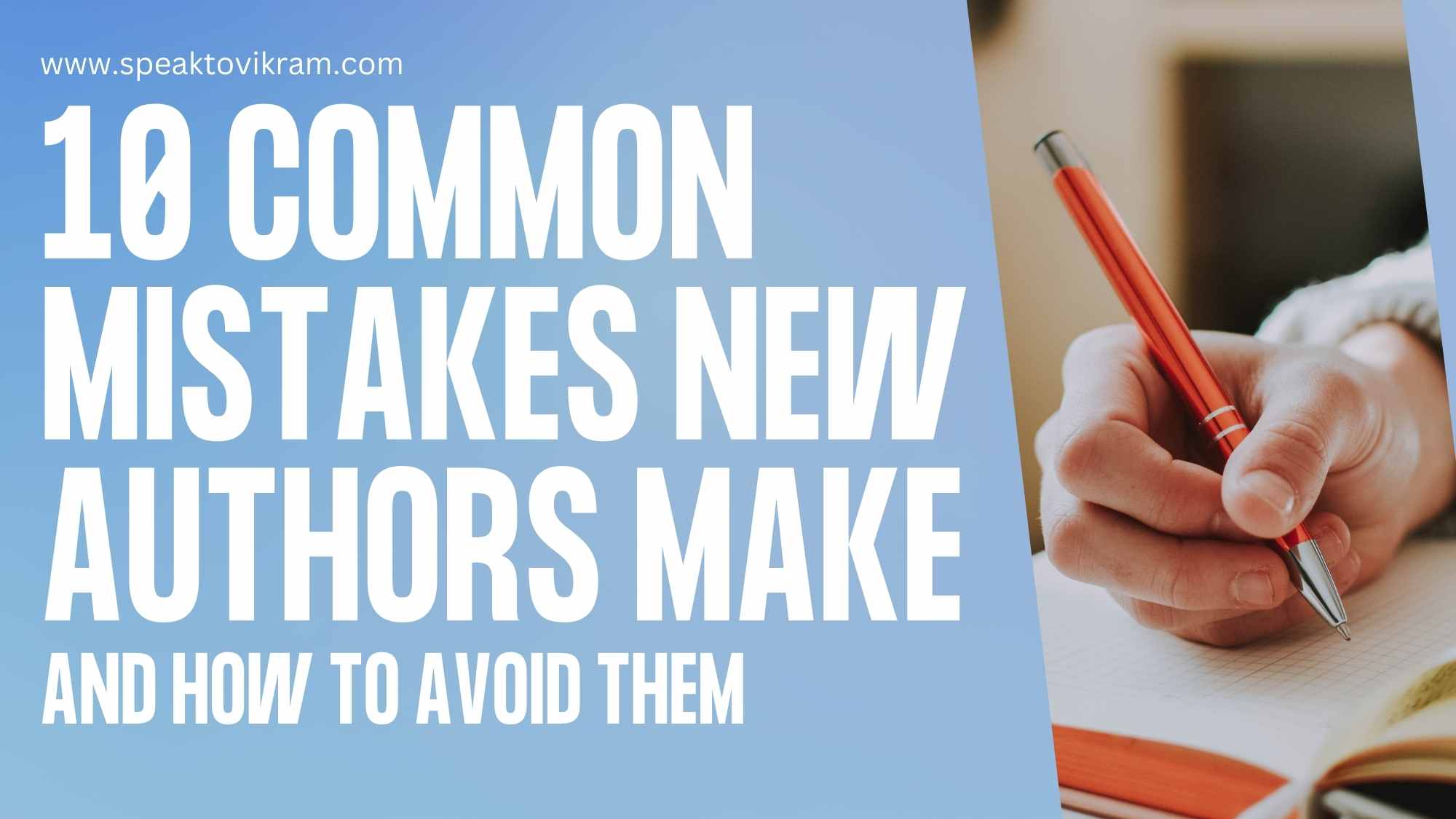1. Introduction
The Journey of a New Author
Becoming a published author is a challenging and exciting journey filled with both triumphs and tribulations. New authors often encounter a myriad of obstacles, from crafting a compelling narrative to navigating the complexities of the publishing world. The writing and publishing journey involves not only honing your craft but also understanding the business side of things, including marketing, design, and legalities. For many, this path can be overwhelming, and the learning curve is steep. Recognizing common pitfalls early on can significantly impact your success, helping you to avoid missteps that could derail your progress and minimize your chances of success.
Why Understanding Mistakes Matters
Understanding and avoiding common mistakes is crucial for new authors who aspire to publish their work traditionally or with self publishing in India. By learning from others’ errors, you can better navigate the complex publishing landscape and improve the quality and marketability of your manuscript. Awareness of these pitfalls will not only help you refine your writing process but also enhance your understanding of the broader publishing industry. Ultimately, recognizing and addressing these mistakes will increase your chances of success, helping you to achieve your writing goals and make a lasting impact in the literary world.
Also Read: How to Publish Your Book Traditionally in India
2. Mistake #1: Neglecting to Plan and Outline
The Risks of a Lack of Planning
One of the most significant mistakes new authors make is neglecting to plan and outline their manuscript. Failing to outline can result in a disorganized manuscript with plot inconsistencies and underdeveloped characters. Without a clear plan, writers may find themselves wandering aimlessly, leading to a story that lacks cohesion and direction. This can be particularly problematic when trying to maintain narrative focus and ensure that all story elements work together seamlessly. A lack of planning can also result in wasted time and effort, as authors may need to undertake extensive revisions to correct issues that could have been avoided with proper preparation.
How to Create an Effective Outline
Creating an effective outline is essential for crafting a well-structured and engaging story. Start by outlining the main plot points and key events of your narrative. This will help you maintain a clear trajectory and ensure that your story remains focused. Develop your characters thoroughly, including their motivations, backstories, and arcs. This will ensure that your characters evolve in a way that supports the overall narrative. Consider using different outlining methods, such as the snowflake method, mind mapping, or chapter-by-chapter summaries, to find the approach that best suits your writing style. An effective outline serves as a roadmap for your manuscript, guiding you through the writing process and helping you stay on track.
3. Mistake #2: Ignoring the Importance of Editing
Why Self-Editing Isn’t Enough
Many new authors believe that self-editing is sufficient for polishing their manuscript. However, self-editing often falls short due to the writer’s inherent biases and familiarity with the text. Authors may overlook inconsistencies, grammatical errors, and structural issues because they are too close to their work. Additionally, self-editing does not address larger issues such as pacing, character development, and plot coherence. Professional editors bring an objective perspective and specialized skills to the table, providing invaluable feedback that can significantly enhance the quality of your manuscript.
Choosing the Right Editing Services
Choosing the right editing services is crucial for improving your manuscript. There are several types of editing to consider:
- Developmental Editing: Focuses on the overall structure, plot, and character development. It addresses big-picture issues and helps you refine your story’s narrative.
- Copyediting: Ensures that your manuscript is free from grammatical, punctuation, and stylistic errors. It improves the clarity and consistency of your writing.
- Proofreading: The final step in the editing process, proofreading involves checking for typos, formatting issues, and minor errors.
Invest in a professional editor who has experience with your genre and understands your vision. Seek recommendations, review portfolios, and discuss your specific needs to find an editor who can help elevate your manuscript to its best version.
4. Mistake #3: Underestimating the Power of a Strong Opening
Consequences of a Weak Beginning
A weak opening can severely impact reader engagement and interest. The first few pages of your manuscript are crucial for capturing the reader’s attention and setting the tone for the rest of the book. A lackluster opening may fail to intrigue readers or provide a compelling reason to continue reading. If the beginning of your book does not establish a strong hook or introduce an engaging conflict, readers may lose interest quickly, which can hinder your book’s success in a competitive market.
Also Read: Develop Writing Habit in 2024
Crafting a Captivating Opening
To craft a captivating opening, start by introducing a compelling hook that grabs the reader’s attention immediately. This could be an intriguing situation, a dramatic event, or a captivating character. Ensure that the opening sets the stage for the rest of the story, establishing the setting, tone, and key conflicts. Aim to create a sense of urgency or curiosity that encourages readers to continue exploring your narrative. Avoid excessive exposition or lengthy backstories; instead, focus on presenting a dynamic and engaging opening scene that draws readers into the world of your book.
5. Mistake #4: Overlooking Target Audience and Market Research
Understanding Your Audience
Understanding your target audience is essential for writing a book that resonates with readers and meets market demands. Many new authors overlook this aspect, leading to manuscripts that fail to connect with their intended audience. Identifying your ideal readers helps you tailor your writing style, themes, and content to appeal to them. Understanding your audience also informs your marketing strategy and ensures that you position your book effectively in the market.
Conducting Market Research
Conducting market research involves analyzing current trends, identifying successful books in your genre, and understanding reader preferences. Research bestsellers and review successful books to identify patterns and trends that resonate with readers. Engage with reader communities, participate in genre-specific forums, and gather insights on what readers are looking for. This information will help you tailor your manuscript to meet market demands and enhance your book’s chances of success.
6. Mistake #5: Skipping the Query Letter and Book Proposal
The Role of Query Letters and Proposals
Query letters and book proposals play a crucial role in attracting publishers and literary agents. A well-crafted query letter provides a concise overview of your manuscript, highlighting its unique aspects and your credentials. A book proposal, typically required for non-fiction works, offers a detailed outline of your book, including its content, target audience, and market potential. Skipping these essential components can hinder your ability to gain representation or secure a publishing deal.
How to Write a Winning Query Letter and Proposal
To write a winning query letter, include a compelling hook, a brief synopsis of your manuscript, and relevant author credentials. Personalize the letter for each agent or publisher, demonstrating that you have researched their preferences and guidelines. For book proposals, include a detailed synopsis, chapter breakdown, market analysis, and a sample chapter. Ensure that both documents are professionally formatted and free from errors. Crafting persuasive and well-organized submissions will enhance your chances of catching the attention of agents and publishers.
7. Mistake #6: Neglecting Professional Book Design
The Impact of Book Design on Sales
Professional book design is crucial for attracting readers and conveying the quality of your book. Poor design can negatively impact the book’s marketability and reader perception. An unattractive cover or poorly formatted interior can deter readers from picking up your book, regardless of its content. Investing in high-quality design ensures that your book stands out in a competitive market and appeals to potential readers.
Investing in Professional Design
Hiring a professional designer for your book cover and interior layout is a worthwhile investment. A professional designer understands market trends, genre-specific aesthetics, and effective design principles. Collaborate with designers to create a cover that captures the essence of your book and appeals to your target audience. Ensure that the interior layout is clean, readable, and professionally formatted. Quality design enhances the overall presentation of your book and contributes to its success.
8. Mistake #7: Ignoring the Importance of a Marketing Plan
Why Marketing Matters for Authors
Marketing is essential for increasing book sales and author visibility. Many new authors underestimate the importance of a strategic marketing plan, leading to missed opportunities for promotion and audience engagement. A well-executed marketing plan helps you reach your target audience, generate buzz, and drive book sales. Without a clear marketing strategy, your book may struggle to gain traction in a crowded market.
Creating an Effective Marketing Strategy
Develop a comprehensive marketing strategy that includes social media promotion, book tours, and promotional events. Utilize social media platforms to connect with readers, share updates about your book, and participate in literary discussions. Consider organizing book launch events, virtual author chats, and book signings to engage with readers and generate interest. Collaborate with book bloggers, reviewers, and influencers to expand your reach. A well-rounded marketing plan will enhance your book’s visibility and contribute to its success.
9. Mistake #8: Rushing the Publication Process
The Risks of Rushing
Rushing the publication process can lead to significant mistakes and a subpar final product. Hasty decisions may result in errors in editing, design, and formatting that can negatively impact the book’s quality and reader experience. Taking shortcuts in the publication process can also lead to missed opportunities for thorough proofreading and quality assurance. Rushing can compromise the overall professionalism and marketability of your book.
Taking the Time to Get it Right
Allow ample time for each stage of the publication process, including editing, design, and review. Ensure that your manuscript undergoes thorough proofreading and revisions before finalizing it for publication. Pay attention to details, such as formatting, design, and quality control. Taking the time to get it right will result in a polished and professional book that meets industry standards and appeals to readers.
10. Mistake #9: Overlooking Legal and Contractual Details
Understanding Publishing Contracts
Publishing contracts contain important legal terms and conditions that can significantly impact your rights and royalties. Many new authors overlook the intricacies of publishing contracts, which can lead to unfavorable terms and potential disputes. Understanding key contractual elements, such as rights, royalties, and obligations, is crucial for protecting your interests and ensuring a fair agreement.
Seeking Legal Advice
Consulting with a literary lawyer or agent is essential for navigating the complexities of publishing contracts. A legal expert can help you understand the terms of the contract, negotiate better terms, and address any concerns you may have. Seeking professional advice ensures that you make informed decisions and protect your rights as an author.
11. Mistake #10: Failing to Build an Author Platform
The Benefits of an Author Platform
An established author platform is vital for book promotion and audience engagement. Many new authors overlook the importance of building a platform, which can hinder their ability to connect with readers and promote their work. A strong author platform helps you establish credibility, build a following, and enhance your visibility in the literary world.
Building Your Platform
Create a professional author website to showcase your work, provide updates, and connect with readers. Develop a strong presence on social media platforms, engaging with your audience and sharing content related to your book and writing journey. Network with other authors, attend literary events, and participate in book-related discussions to expand your reach. Building a robust author platform takes time and effort but is essential for long-term success and effective book promotion.
12. Conclusion
Recap of Common Mistakes and Solutions
Understanding and addressing common mistakes can significantly enhance your success as a new author. From planning and editing to marketing and legal considerations, avoiding these pitfalls will help you produce a polished manuscript and navigate the publishing process more effectively. By recognizing these common errors and implementing solutions, you can improve the quality of your work and increase your chances of achieving your writing goals.
Encouragement for New Authors
As you embark on your writing journey, remember that persistence and continuous improvement are key to success. Embrace the learning process, seek feedback, and remain open to growth. Every mistake is an opportunity to learn and refine your craft. Stay motivated, keep writing, and continue to pursue your passion for storytelling.
13. Additional Resources
Books and Guides for Aspiring Authors
- “On Writing: A Memoir of the Craft“ by Stephen King
- “Bird by Bird: Some Instructions on Writing and Life“ by Anne Lamott
- “The Elements of Style“ by William Strunk Jr. and E.B. White
Useful Websites and Tools
- Writer’s Digest – Offers articles, advice, and resources for writers.
- Grammarly – A tool for grammar and style checking.
- Reedsy – Connects authors with professional editors, designers, and marketers.
- Canva – Helps authors to design beautiful book covers and posters for free.
By leveraging these resources and avoiding common mistakes, you can improve your manuscript, enhance your publishing prospects, and achieve your goals as an author.



